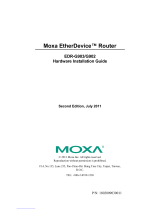
- 2 -
Package Checklist
The EDS-510A is shipped with the following items. If any of these items
are missing or damaged, please contact your customer service
representative for assistance.
• 1 EDS-510A EtherDevice Switch
• Hardware Installation Guide (this guide)
• CD-ROM with user’s manual and Windows utility
• Moxa product warranty statement
• RJ45 to DB9 console port cable
• Protective caps for unused ports
• DIN-Rail mounting kit (attached to the EDS-510A’s rear panel by
default)
Optional Accessories
• SFP-1GSXLC: Small Form factor Pluggable transceiver with
1000BaseSX, LC, 0.5km, 0 to 60°C
• SFP-1GSXLC-T: Small Form factor Pluggable transceiver with
1000BaseSX, LC, 0.5km, 20 to 75°C
• SFP-1GLXLC: Small Form factor Pluggable transceiver with
1000BaseLX, LC, 10km, 0 to 60°C
• SFP-1GLXLC-T: Small Form factor Pluggable transceiver with
1000BaseLX, LC, 10km, -40 to 75°C
• SFP-1GLHXLC: Small Form factor Pluggable transceiver with
1000BaseLHX, LC, 40 km, 0 to 60°C
• SFP-1GLHXLC-T: Small Form factor Pluggable transceiver with
1000BaseLHX, LC, 40 km, -40 to 75°C
• SFP-1GZXLC: Small Form factor Pluggable transceiver with
1000BaseZX, 80 km, LC, 0 to 60°C
• ABC-01: Automatic Backup Configurator via RS-232 Console Port, 0
to 60°C
• DR-4524—DIN-Rail Power Supply (24 VDC, 45W/2A, with 85 to 264
VAC input)
• DR-75-24—DIN-Rail Power Supply (24 VDC, 75W/3.2A, with 85 to
264 VAC input)
• DR-120-24—DIN-Rail Power Supply (24 VDC, 120W/5A, with 88 to
132 VAC/176 to 264 VAC input by switch)
• EDS-SNMP OPC Server Pro—CD with EDS-SNMP OPC Server
software and user’s manual
• WK-46—Wall Mounting Kit (will be shipped with the product)
• RK-4U—4U-high 19" rack mounting kit






















